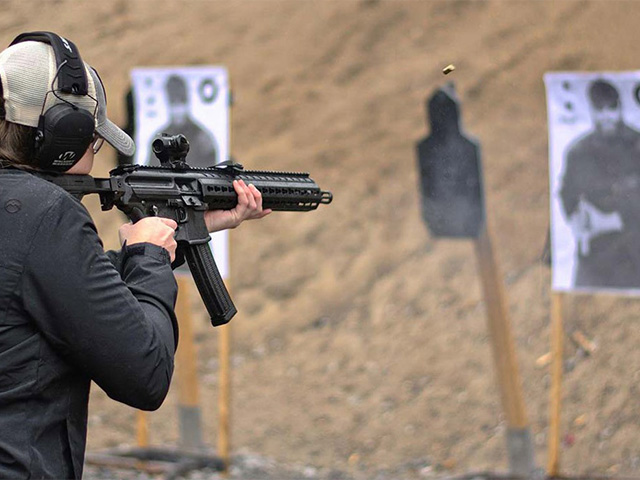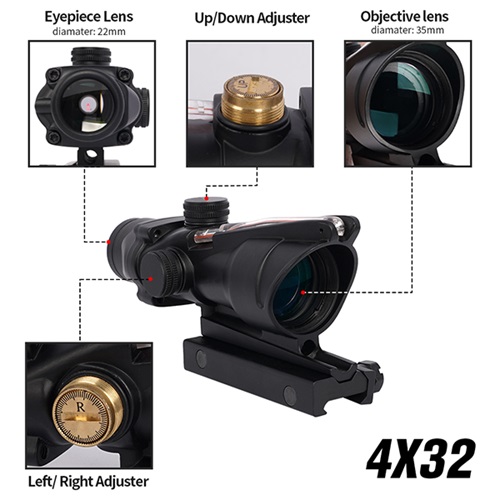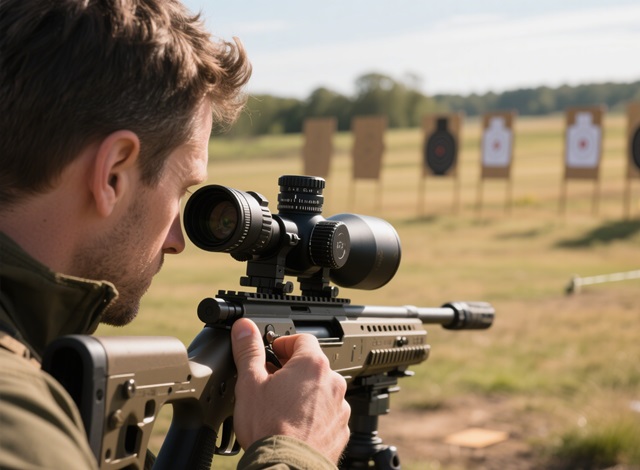Sighting in a rifle scope isn't just a technical step—it's a foundation for accuracy. Without a proper zero, even the most advanced optic becomes guesswork. Whether you're prepping for hunting season or tightening your groups at the range, this process sets the tone for every shot you'll take.

Sighting in—or zeroing—a scope is the process of adjusting the optic so that the crosshairs align with the bullet's actual point of impact at a given distance. It's a straightforward idea, but one that requires attention to detail.
Once your rifle is zeroed, you can stop wondering where your rounds will land. You aim, and the bullet goes exactly where the reticle points—at least at that calibrated distance. This alignment forms the basis of consistent accuracy, especially when shooting beyond 50 or 100 yards.
It also helps you learn how your bullet behaves. Projectiles don't travel in straight lines. They arc due to gravity, and that curve must be accounted for. When you zero a scope, you're setting a reference point for that arc.
Your chosen distance depends on what you shoot and how. Target shooters may
zero at 100 yards, hunters at 200. For some, a 50/200-yard zero balances short
and long-range usability. There's no universal answer—only what best supports
your shooting environment.
A stable platform is the first priority. Whether it's a bipod, a bench rest, or sandbags, your rifle needs to stay still during the process. Movement ruins group consistency and makes meaningful adjustments impossible.
Paper targets with 1-inch grids work well for visual reference. They're simple and help measure how far shots land from center. Opt for high-contrast designs that are easy to see through your optic, especially at lower magnifications.
Use the same ammunition throughout. Even small variations in bullet weight or case pressure can shift your impact points. If you change brands midway through zeroing, your earlier data becomes irrelevant.
Bring tools for turret adjustments. Some scopes adjust by hand; others require coins or screwdrivers. If your optic has locking turrets, know how to disengage them before heading out.
A spotting scope or binoculars will help check groups without walking to the target after each volley. It saves time, maintains your shooting position, and keeps the process fluid.
Finally, a laser bore sighter can simplify initial alignment. While not mandatory, it can help you land your first shots on paper, which speeds things up and reduces wasted rounds.

Before any adjustments can happen, the scope has to be installed correctly. Even a well-made optic won't hold zero if the mount is off.
Start by securing the rings and base with proper torque. Too loose, and the scope shifts under recoil. Too tight, and you risk damaging the tube. Torque drivers remove the guesswork and prevent long-term issues.
Level the scope. The vertical and horizontal reticle lines must align with the rifle's bore. Even a slight tilt can cause bullets to drift diagonally at range. Use bubble levels or an alignment tool to double-check before locking everything down.
Set the correct eye relief. This is the distance where your full sight picture appears without dark edges. Too far back, and you lose field of view. Too close, and you risk recoil bite. Eye relief matters for both safety and comfort.
Reticle alignment and consistent torque are often overlooked—but they have
direct effects on the outcome of your sight-in session. Every error made during
mounting creates problems you'll chase later with unnecessary adjustments.
This step helps get the optic and barrel roughly aligned before live fire. It's not about precision—it's about efficiency.
If you're using a bolt-action rifle, remove the bolt and look through the bore at a clear point 25 yards away. Without moving the gun, adjust the scope so the crosshairs aim at the same object. That's a basic visual bore sight.
Laser options make it easier. Chamber-insert models mimic live rounds and shine a red or green dot where the barrel points. Others fit into the muzzle. Both let you match the reticle to the dot without firing a round.
Bore sighting doesn't replace range work, but it gets you close enough that
your first shots will likely hit the paper. It reduces trial and error and gets
you into the fine-tuning phase faster.
Start at 25 yards. This short distance removes long-range variables like wind and drop, making it easier to focus on basic alignment.
Fire a three-shot group without changing anything between shots. Don't chase single bullet holes. Instead, find the center of the group and measure its offset from the bullseye. That's the real information you need.
Make your elevation and windage corrections using your scope's turret system. If it adjusts in 1/4 MOA, four clicks move your point of impact one inch at 100 yards. At 25 yards, you'll need 16 clicks to shift an inch. Do the math based on your distance and optic.

After adjustments, fire another group. Keep repeating until your rounds hit center consistently. Once you've zeroed at 25, step back to 50 yards and repeat the process. Then again at 100 yards—your final zero distance for most general shooting purposes.
It helps to let the barrel cool between groups. A hot barrel can change bullet behavior, especially in thinner sporter profiles. Staying consistent with rest position and grip also ensures that you're testing the optic—not your form.
Take your time. Rushing to get centered wastes more ammo than going slowly
and making deliberate corrections. Once you're hitting the mark consistently,
you've got your zero.
Your job isn't over once the 100-yard bullseye is dialed in. You need to confirm how your rifle behaves at other distances too.
Try shooting at 50, 150, and 200 yards. You'll begin to see how bullet trajectory shifts over range. Maybe your 100-yard zero is two inches high at 50 yards and three inches low at 200. That's useful knowledge, especially if you're shooting in varied environments.
Different bullet types produce different arcs. The only way to know for sure is to test. One grain weight may shoot flat across a wide range; another may drop significantly after 150 yards.
Write it down. Build your own drop chart based on live-fire data. You'll use it more often than you think.
Also, use this time to assess how well your scope tracks. Dial up for 200 yards, then back to 100. Does your impact return exactly where it was? If not, there may be mechanical play in your turrets—something you'll want to know before relying on it.
Confirmation isn't just technical. It's also about building familiarity. It
tells you how your rifle feels when everything is working right. That kind of
knowledge carries over into every shooting session afterward.
A scope isn't useful until it's zeroed. Sight-in is where your equipment and your skill start working together. It takes time. It takes patience. But it's worth every minute.
If you're working with new setups, adjusting for multiple uses, or need support selecting the right optic or accessory combination, we offer a full range of solutions. For custom options, OEM/ODM support, or expert guidance, contact us at cc1535@gmail.com.